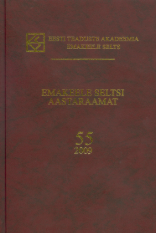EESTI KEELT EMAKEELENA OMANDAVATE KUUEAASTASTE LASTE SÕNAVARA SEOSED EMADE SÕNAVARAGA
VOCABULARY OF 6-YEAR-OLD ESTONIAN-SPEAKING CHILDREN AND THEIR MOTHERS
Author(s): Andra Kütt, Reili ArgusSubject(s): Language acquisition, Sociolinguistics, Finno-Ugrian studies, Family and social welfare
Published by: Eesti Teaduste Akadeemia Kirjastus
Keywords: first language acquisition; sociolinguistics; word classes; childdirected speech; vocabulary; Estonian;
Summary/Abstract: Studies on the acquisition of vocabulary of preschoolers and the relationships between social environment and child vocabulary are relatively scarce in Estonia. The goal of the article is to describe, on the basis of recorded everyday conversations (six hours of recorded material in total), the vocabulary and the use of word classes in six-year-old Estonian-speaking children and to demonstrate how the vocabulary of a child depends on the vocabulary of the parent. This study is the first attempt to describe the vocabulary of Estonian children belonging to a specific target group (the children’s mothers have all higher education). The results indicate that the vocabulary, distribution of word classes and frequency of words of a specific word class of six-year-old children are closely related to the language use of the parent. The vocabulary of children consisted of about 415-498 lexemes within a recording, whereas the mothers interacting with their children used 557-798 lexemes during the same time span. Like their parents’, the preschoolers’ vocabulary is in general verb- or adverb-based. Although the parents used somewhat more verbs than their children, child-directed speech provides children with a general distribution of word classes and the frequency of words inside a specific word class, that is, children’s distribution of word classes are similar to their parents’. Both the parents and the children used very few adjectives, whereas there are even less adjectives in the parents’ than in the children’s speech. The amount of parent speech (measured in tokens) in the recording was 47% greater than the amount of child speech.
Journal: Emakeele Seltsi aastaraamat
- Issue Year: 2017
- Issue No: 63
- Page Range: 77-102
- Page Count: 26
- Language: Estonian

